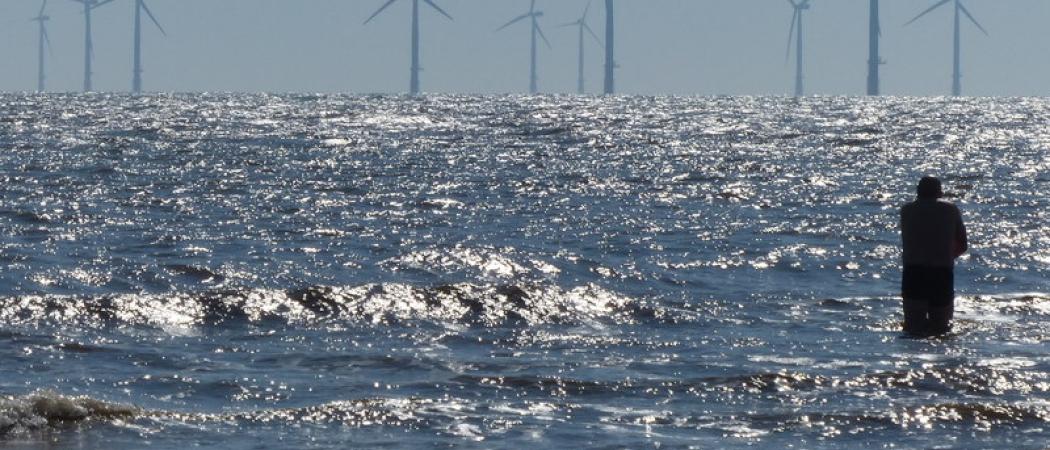From a standing start, President Biden has set a target for offshore windfarms to be generating 30 GW of electricity by 2030. With their 30 years of experience, European wind energy companies are playing a part

View east towards the Lynn Offshore Windfarm. Photo: Mat Fascione, Wikimedia Commons
The technology exists, but to succeed, a new Biden administration clean energy initiative now needs to pick its way through the thickets of government red tape, environmental objections and other stumbling blocks that have left the US a global laggard in deploying offshore wind.
This is despite important technical advances made in the US, such as the development of lighter turbine blades that make windfarms cheaper to install and more efficient in their operation - and which shift the economics of installing large offshore windfarms.
The Biden plan, with its aim to develop the world’s largest offshore windfarm, has been forced to look beyond the capabilities and potential of the available technologies, to include measures that speed up delivery of projects. That includes streamlining the convoluted US federal permitting system and investing in new energy supply chains, manufacturing, shipbuilding, servicing, and workforce development.
Significantly, a central assumption of the Biden plan is that cutting-edge technology isn’t enough to implement net zero agendas. Clear mandates among partners and support from communities near the windfarms are crucial, as is having a process for everything from quicker lease approval, to transporting the windfarm components out to sea and assembling them.
This insight could hold important lessons for Europe as it lays the groundwork to enable the scale-up and widespread implementation of other more nascent green technologies, in pursuit of the EU aim to be climate neutral by 2050. These technologies, such as green hydrogen, that are in development in a variety of EU research and innovation programmes, will require similar reshaping of policy, infrastructure and culture, if they are to succeed.
Clean energy policy
The US is betting its more collaborative plan will advance its windfarm deployment. Until now, individual US states have led a piecemeal effort to implement offshore wind energy. The joint plan between the White House and 11 East Coast states, known as the Federal-State Offshore Wind Implementation Partnership, will include combined efforts to train the workforce, remove supply chain constraints, transmit electricity to shore, interconnect to the grid, and build port capacity.
Wind energy is a cornerstone of Biden’s clean energy policy. Some $450 million annually of his $1 trillion infrastructure law is targeted at port infrastructure, with a preference for wind ports, like that proposed for New Jersey, to support offshore wind activities, and longer term, to house offshore wind manufacturing facilities. Biden has been rolling out parts of his wind strategy over the past couple years, including streamlining the complex federal permitting process and auctioning offshore leases.
The plan would help push forward the Biden administration’s goal of deploying 30 gigawatts of offshore wind by 2030, enough to power 10 million homes, support 77,000 jobs, and jumpstart $12 billion annually in private investment in the projects. A recent US Supreme Court ruling to limit the country’s Environmental Protection Agency’s ability to regulate greenhouse gas emissions will not affect the new plan.
“The 30-gigawatt goal is ambitious, equal to almost the entire offshore wind around the whole world now, but it is very doable,” said Erin Baker, a professor of industry engineering and operations research at the UMass Amherst Wind Energy Center.
UK academic Guy Houlsby, professor of engineering at Oxford University, whose specialties include offshore wind power, is more conservative in his assessment, saying not many details came out in the US announcement. “The US is behind Europe in this area, so I suppose it is good that they are planning an initiative,” Houlsby said.
For Baker, the US is making some concrete steps. She said streamlining and coordinating the federal approval process, which has involved a nod from each of seven federal agencies, is very important to moving the industry forward. Added to federal approvals are state and local agencies. She believes the US offshore wind industry, with two approved projects, has lagged because of the many layers of approvals.
While the plan centres on building up American know-how in offshore wind, there a heavy presence of European companies with more developed technology and expertise in existing and planned US projects. They include Orsted of Denmark, Iberdrola of Spain via its US subsidiary Avangrid Renewables, and Engie of France.
Baker expects cross-Atlantic collaboration on the US wind projects, with the Biden impetus to catch up in wind power and the larger goal of developing technologies to combat climate change in mind.
“Almost all US projects will be with European developers,” she predicted.
Archaic federal statute
Another key to offshore wind is a recent initiative to incentivise the building of ships to transport large turbine parts to their offshore locations, by designating them as Vessels of National Interest, Baker noted. The designation will enable shipbuilders to access government loans.
So, too, is the new emphasis on developing ships that can transport the large components of windfarms out to sea. An archaic federal statute that is more than 100 years old, the Jones Act, restricts water transportation between US ports to US-owned ships only. The new initiative will prioritise funding for wind vessels that can transport large turbine parts offshore, Baker said.
Even though the plan centres on building up American know-how in offshore wind, there still is a heavy presence of European companies with more developed technology and expertise in existing and planned US projects. They include Orsted of Denmark, Iberdrola of Spain via its US subsidiary Avangrid Renewables, and Engie of France.
Financial support will come from federal sources, including the US Department of Energy, and from private industry that is expected to invest in offshore wind projects. Already, six offshore leases for potential wind projects off of New York and New Jersey sold in February for a record $4.3 billion.
The moves come as global capital expenditures on offshore wind are expected to more than double from $46 billion in 2021, to $102 billion in 2030, according to Rystad Energy, an independent energy research company based in Oslo. Driving that growth is a significant uptick in installations in Europe, where capital expenditures are forecast to approach $53 billion in 2030, up from $15 billion last year.
The Americas have been slow to enter the market, but that will change starting this year, when the region will spend $3.3 billion, up from $700 million last year. That will rise to almost $15 billion by 2030, Rystad said. The Biden plan said that in 2021 alone, there will $2.2 billion in new funding. Amongst other elements, that will pay for nine major facilities where the foundations, towers, cables, and blades of offshore wind turbines will be manufactured.
China invested almost $25 billion in windfarms in 2020, double what Europe spent in that year, but its total expenditure is expected to gradually decline to $7.7 billion in 2030. Rystad attributed the slowdown to a phase-out last year of feed-in tariffs that encouraged energy infrastructure investments.
The US has faced opposition to offshore wind by local communities to a degree not experienced elsewhere. It has two permitted windfarms to date. Local residents near the Vineyard Wind windfarm under construction 24 kilometres off of the northeast state of Massachusetts have protested it would be an eyesore and a danger to North Atlantic Right whales. Commercial fishermen said it would harm their fishery. It will be the nation’s first utility-scale offshore wind energy project.
In Maine, a proposed experimental offshore floating windfarm, part of that state’s effort to fully use renewable energy by 2050, also faced stiff pushback from the commercial fisheries, a key part of the state’s economy. The governor’s representatives and the fisheries industries met several times and agreed to a compromise that would keep offshore windfarms from being located too close to shore. The state has since applied for a federal permit for the pilot project.
The Block Island Wind Farm, which was the first US permitted offshore windfarm, is in the Atlantic Ocean about 6 kilometres off the Rhode Island coast. The 30-megawatt farm with five turbines began commercial operations in December 2016. It is owned by Denmark’s Orsted, which purchased it from its founding investors in 2019.
Two more projects are in the works in Massachusetts, with two utility companies filing long-term plans with the state to develop Commonwealth Wind, which has financial support from Avangrid Renewables, US subsidiary of Iberdrola, and Mayflower Wind, backed by a joint venture involving Engie. The two projects would add 1,600 megawatts of power to the grid.
The existing projects still are small compared to the 50 gigawatts of electricity the UK government plans to have generated by wind by 2030. Some 5 gigawatts of that is to come from offshore floating platforms. The UK is second only to China worldwide in wind development.





 A unique international forum for public research organisations and companies to connect their external engagement with strategic interests around their R&D system.
A unique international forum for public research organisations and companies to connect their external engagement with strategic interests around their R&D system.